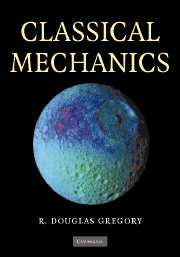Book contents
- Frontmatter
- Contents
- Preface
- 1 Newtonian mechanics of a single particle
- 1 The algebra and calculus of vectors
- 2 Velocity, acceleration and scalar angular velocity
- 3 Newton's laws of motion and the law of gravitation
- 4 Problems in particle dynamics
- 5 Linear oscillations
- 6 Energy conservation
- 7 Orbits in a central field
- 8 Non-linear oscillations and phase space
- 2 Multi-particle systems
- 3 Analytical mechanics
- 4 Further topics
- Appendix Centres of mass and moments of inertia
- Answers to the problems
- Bibliography
- Index
8 - Non-linear oscillations and phase space
Published online by Cambridge University Press: 05 September 2012
- Frontmatter
- Contents
- Preface
- 1 Newtonian mechanics of a single particle
- 1 The algebra and calculus of vectors
- 2 Velocity, acceleration and scalar angular velocity
- 3 Newton's laws of motion and the law of gravitation
- 4 Problems in particle dynamics
- 5 Linear oscillations
- 6 Energy conservation
- 7 Orbits in a central field
- 8 Non-linear oscillations and phase space
- 2 Multi-particle systems
- 3 Analytical mechanics
- 4 Further topics
- Appendix Centres of mass and moments of inertia
- Answers to the problems
- Bibliography
- Index
Summary
KEY FEATURES
The key features of this chapter are the use of perturbation theory to solve weakly non-linear problems, the notion of phase space, the Poincaré–Bendixson theorem, and limit cycles.
In reality, most oscillating mechanical systems are governed by non-linear equations. The linear oscillation theory developed in Chapter 5 is generally an approximation which is accurate only when the amplitude of the oscillations is small. Unfortunately, non-linear oscillation equations do not have nice exact solutions as their linear counterparts do, and this makes the non-linear theory difficult to investigate analytically.
In this chapter we describe two different analytical approaches, each of which is successful in its own way. The first is to use perturbation theory to find successive corrections to the linear theory. This gives a more accurate solution than the linear theory when the non-linear terms in the equation are small. However, because the solution is close to that predicted by the linear theory, new phenomena associated with non-linearity are unlikely to be discovered by perturbation theory! The second approach involves the use of geometrical arguments in phase space. This has the advantage that the non-linear effects can be large, but the conclusions are likely to be qualitative rather than quantitative. A particular triumph of this approach is the Poincaré–Bendixson theorem, which can be used to prove the existence of limit cycles, a new phenomenon that exists only in the non-linear theory.
- Type
- Chapter
- Information
- Classical Mechanics , pp. 194 - 218Publisher: Cambridge University PressPrint publication year: 2006
- 1
- Cited by



